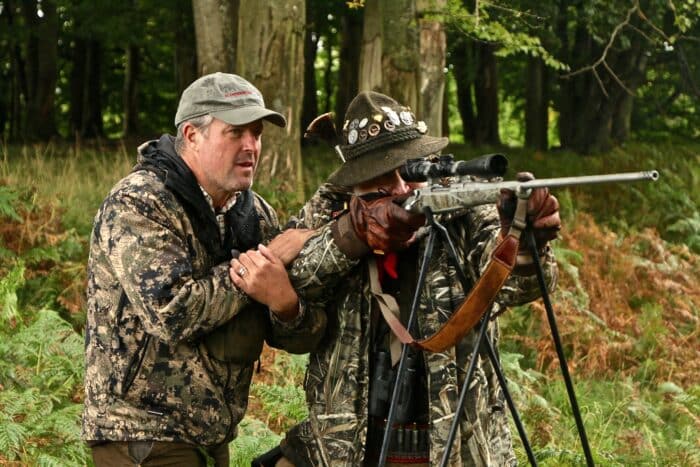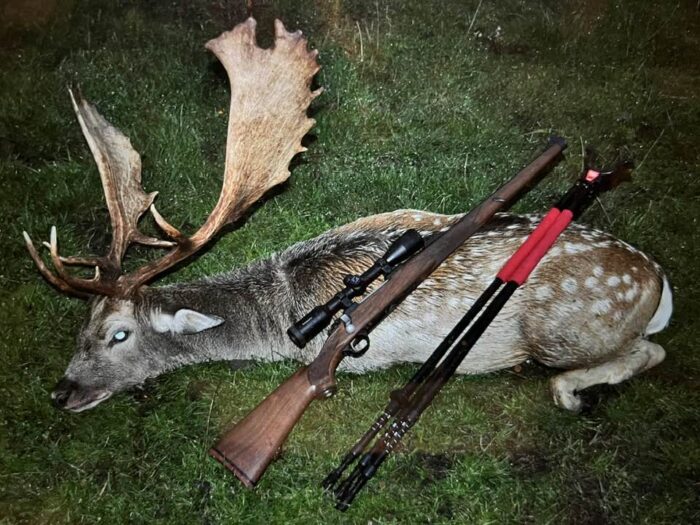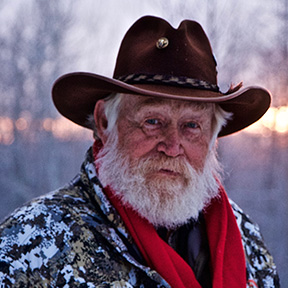Fallow Deer in Denmark
“That was not a roe deer! Not with those antlers!” Quipped I as a large set of tall, many-tined palmate antlers seemingly floated just above and behind a rock wall. I glanced at Stefan Bengtsson. My outfitter/guide/fellow wildlife biologist and, more importantly, friend grinned. “That had to have been a fallow buck unless it was really palmate red stag!”
“You are very observant my long way from Texas compadre!” Countered he. “Hmmm…like, that Compadre thing? I learned the word while Sofia and I were at the DSC Convention a few years ago.”
Now, it was my time to smile and nod. “You didn’t tell me you had huge fallow bucks in this area?”
“Been here for many, many years. Brought to Sweden and Denmark probably about the same time, they were brought to Britain by the invading Normans bn the eleventh century. As you probably know fallow deer were originally from the central and eastern lands of the Mediterranean. There are two subspecies of the Dama dama deer, European and Persian fallow deer. They look the same, but the European strain of fallow deer tend to have larger palmate antlers than the Persian subspecies.” Stefan continued, “Based on fossil records, fallow deer first appeared in Europe during the Middle Pleistocene, which started about 2.6 million years ago. So they’ve been around for quite some time.”
“The Normans and other invaders brought herds of fallow deer with them. Some were kept in enclosures; others were released to populate newly conquered lands, to provide future food for soldiers but also settlers that followed.” Stefan continued, “There are some who believe fallow deer were moved into new areas, by humans, where they previously did not exist as far back as 9,000 years ago.”
“Yes, Sir, I have seen them on ranches throughout Texas, a few other states, in New Zealand, in the southern part of Africa, in Australia, as well as, of course, in several European countries. I, too, have noticed there are some fallow deer that are pure white, others that are dark brown, almost black, and a lot too are brownish with white spots. I’ve primarily seen the latter here in Europe.” Then I quickly asked, “Is the fallow deer hunting season open?”
“No, it opens later in the year. Guess you’ll have to come back in the Fall…” Said my friend who, with his wife Sofia, also a professional wildlife biologist, owns and operates Scandinavian Prohunters, the finest hunting operation, in my opinion, in all of Europe when it comes to the Continent’s big game species as well as waterfowl and pheasants.
At the time,I was hunting roe deer in Sweden with Stefan and Sofia. With them, I had previously hunted roe deer and red stag in Sweden, reindeer in Norway, highland red stags in Scotland, and more than a few ducks with them. Sweden, through Scandinavian Prohunters, offers some of the finest waterfowl and pheasant hunting, as well as other game birds, in the world!
“Please book me on a fallow deer hunt! I’d love to hunt during their breeding season when the bucks are moving and are rather vocal, making deep guttural grunts.” I knew such a hunt would be most interesting, fun, and successful in many ways. Stefan said we would do the paperwork later that evening. “We’ll set it up for October, which is the middle of the month. That work for you?” asked Stefan. It would.
And that is how I happened to be in Denmark with Stefan and the local gamekeeper, Hans, on a huge estate hunting rutting fallow bucks in pouring rain. “Pouring” being a term with several levels and degrees of water falling from tall gray clouds.
Our hunt plan was to still hunt through forests, along the edges of open glens, just into trees bordering planted fields, and weaving along the edge of deep cuts leading to the Baltic Sea. At the time, I was being filmed for my back-then TV show, “DSC’s Trailing the Hunter’s Moon.” My cameraman Dustin Blankenship not only had to follow us “over hill and dale” but also had to keep his camera dry enough to record my hunt. He did an admirable job!
On the first day of the hunt, we saw does and younger bucks, but no older mature bucks with tall, wide, and widely palmate antlers. But then it rained hard all day long. By day’s end, we had walked several miles, and even though we wore the finest and best rain gear possible, the three of us were soaked.
That night, back “home” in Sweden at Stefan and Sophia’s home, after hot baths and a “couple” of glasses of “safe water,” we enjoyed a fabulous meal topped off with “safe water” stirred into deliciously strong black coffee while we regaled, pursuing great stags, which we bested, but mostly which bested us.
As is so often the case in hunting camp, this time a palatial home over 400 years old, it did not take long to spend the night.
Shortly after first light we were back in Denmark on the large estate where we had hunted the day before. The rain had not stopped, but it had at least slowed a bit for the time being.
First buck we saw that morning was HUGE; many tined, massive beams and w-i-d-e palmate antlers. He had so many points I kept losing count. I finally gave up trying to come up with a total. His spread was WIDE! His overall antler height exceeded how tall he was at his shoulder, thus easily 3 feet… Impressive!
I glanced at Stefan. He was shaking his head in a negative manner. I knew that meant this was not a buck I would be shooting. My intention was to take a good, mature representative for Denmark fallow buck. One, I would not have to mortgage my home to pay for after I had taken him. On many European hunts, costs are based on antler or horn sizes. The larger the antlers or horns, the higher the price tag. Stefan had again explained to the gamekeeper the type of buck I was looking for, and could afford.
After seeing and glassing the monster buck, we spotted numerous other bucks, also does. One of the buck’s antlers looked good, but he was young. Most European hunting lands and wildlife populations that live on the property are properly, if not intensively managed. Only specific bucks as well as certain does, are harvested to maintain a healthy deer herd or herds if there are several species on the same property.
We stopped under an ancient tree when rain again started falling hard. It reminded me of some of the oak trees I grew up around in Texas. From there, we spotted a buck that made Hans smile. Obviously, he appeared to be in the category, size, and age I was looking for. After a couple more looks at the deer, Hans indicated that I should load a 180-grain SST Hornady round into my 300 Win Mag Ruger rifle.
Earlier, shooting at the bench at 100 meters on Stefan’s range, I had placed three shots in a tight cloverleaf in the X-ring. With my combination of rifle and Hornady ammo, I felt comfortable taking a long shot, but if at all possible, I hoped to stalk within 100 yards or less before shooting.
Bent to the waist the gamekeeper started walking toward the buck. I followed in similar fashion as did Stefan and Dustin. No sooner had we started than it began raining really hard! It was raining so hard the gamekeeper raised upright and walked into the wind quickly cutting the distance. When it started raining harder, the buck walked under the cover of a huge tree.
We stopped seventy yards away from him. As we did, the wind increased dramatically. The gamekeeper set up shooting sticks and then told Stefan to tell me to shoot the buck when it provided a shot. I quickly got into position on sticks. But the wind was blowing so hard that even on sticks, I was having a hard time staying on target. I sat down and repositioned the shooting sticks. But I immediately realized I could not see the buck above the tall waving underbrush.
I stood up, repositioned the shooting sticks, and then asked Stefan to stand next to me and support my right elbow. Once he did, I was rock solid on the buck.
Looking through the scope, his antlers looked REALLY big. I looked at Stefan and the gamekeeper. The one who oversaw the hunting and taking of specific animals on the property said, “Chute!”. Crosshairs settled on the buck’s shoulder, I pushed “safe” to “fire” let out what breath I had left in my lungs, then started applying pressure on the trigger.
At the shot, the buck disappeared, falling to the ground. I bolted in another Hornady round and tried to find him in my scope. I could not see his body, but, I did see the tip of his right main beam just above the tall, waving underbrush.
Approaching the buck, his antlers and body “grew” larger with each step toward him. Stefan was smiling. I glanced at the gamekeeper. I could see a questioning and then a pained look come on Hans’ face. The closer we got, the bigger the fallow deer grew.
At the buck’s side, I again looked at the gamekeeper. His face showed concern. I also noticed my buck likely weighed 300 pounds. This is opposed to around 200 pounds for a “normal” fallow buck. His body had made his antlers look merely good and representative. Now next to him, I realized I had shot a monstrous buck, in both body and antlers.
Hans stared at the ground, shook his head several times…then turned to face me, smiling while extending a congratulatory hand. I shook his hand and then Stefan’s. After showing proper respect to the deer taken, which I truly appreciate, we did a few more “television things” and prepared to photograph my buck.
When Stefan kneeled at my side for photos, he explained the conversation he and Hans had while Dustin and I had done “TV things.” “Your buck has a huge body, so big it made his antlers not look as big as they actually are. As you know, his antlers are huge, bigger than our objective. Hans told you to shoot the buck, and to tell you not to worry about the antlers being as big as they are. Enjoy and relish the moment.” I did! And I still do every time I look at the photos of my buck.
I had a European skull mount done of my buck and left it with Stefan. Later, I told him and Sofia that doing so would require an open invitation from them for me to return occasionally to visit my Denmark fallow buck.
Thinking about that fallow buck and vividly remembering that hunt I think it is about time for me to return to Sweden and Denmark!
Professional wildlife biologist/outdoor communicator, Larry Weishuhn, known to many as “Mr. Whitetail”, has established quality wildlife management programs on over 12,000,000 acres throughout North American and other parts of the world. He has hunted big game with rifle and/or handgun on six continents. Larry is a Professional Member of the Boone & Crockett Club, life-member of numerous wildlife conservation organizations including the Dallas Safari Club, Mule Deer Foundation, and Wild Sheep Foundation. He currently serves on the DSC Foundation Board of Directors, is one of three co-founders of the Texas Wildlife Association; is a member of the Legends of the Outdoors Hall of Fame and the Muy Grande Hall of Fame; he too, received the Zeiss Lifetime Achievement Award among many other honors.





